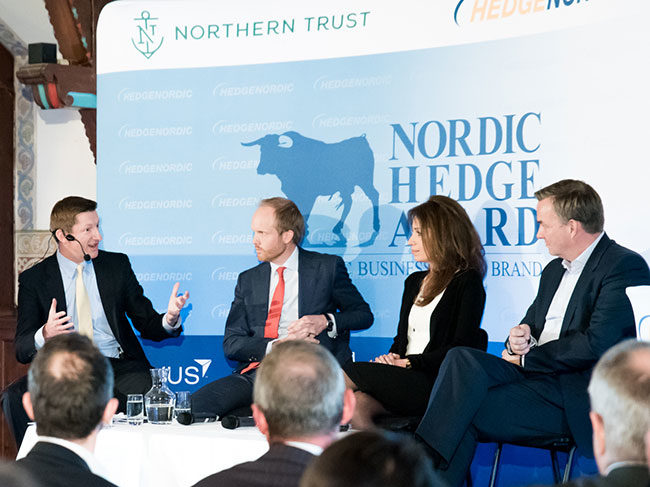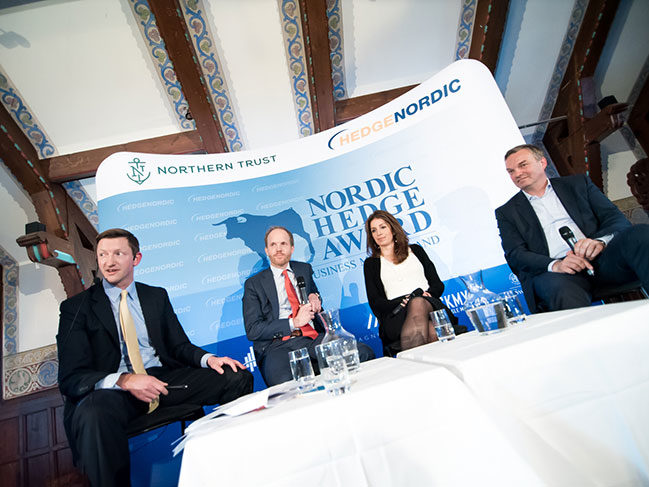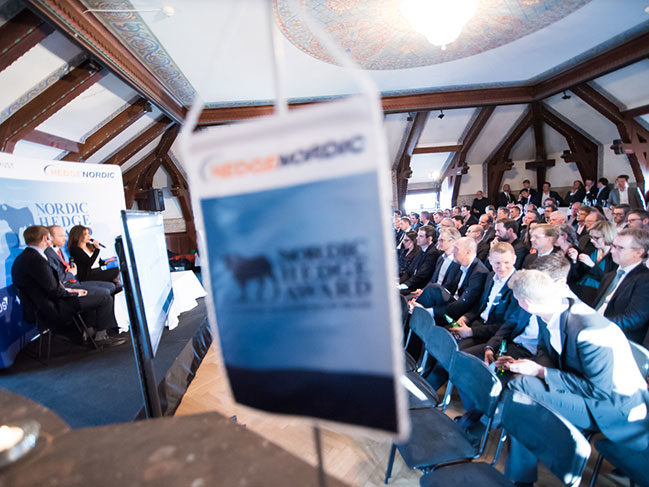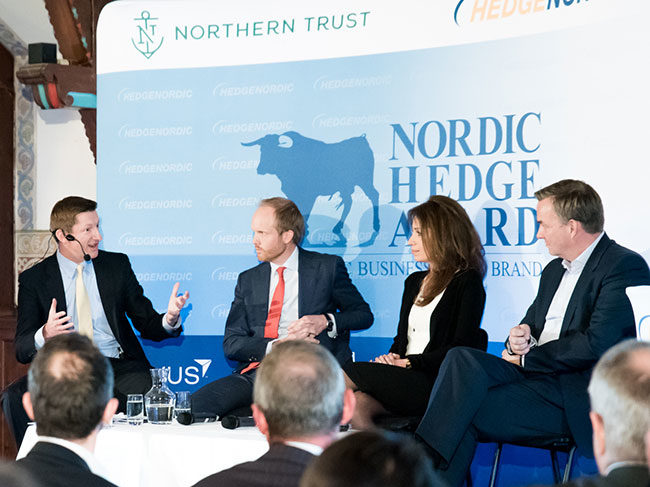What’s next for a hedge fund business?
Stockholm (HedgeNordic) – Attracting institutional assets is often seen as the Holy Grail for hedge fund managers but with the opportunity also comes challenges. As the industry becomes more institutional demands on performance, liquidity, transparency and infrastructure increase.
At this year’s fourth Hedge Nordic Award, held in Stockholm, the podium discussion focused on how to meet these challenges. The panellists discussed strategies for hedge funds trying to grow assets, develop their businesses or simply seeking to protect the status quo. The discussion was moderated by Struan Malcolm, Head of Nordic Sales at Northern Trust.
Struan Malcolm started the discussion by asking what key drivers are impacting the interaction between hedge funds and hedge fund investors.
Mats Langensjö of Lombard Odier Investment Management, said hedge funds have a role to play as institutional investors’ appetite for returns continue, adding that hedge funds offer a counter weight to the herding mentality in traditional asset classes by offering uncorrelated strategies. “But the question is price and whether they can afford a meaningful allocation,” he said.
Despina Xanthopoulou, who has been with Lynx asset Management for the past 6 months and still has much of an ‘external view’, said the firm is very much focused on performance rather than growing assets. The CTA managed by Lynx is one of the largest in the world with $6.5 billion in AUM and as such is very resource intense. Last year the company hired 15 people in total and quite a few in the analyst team in order to improve the models. “When you focus on returns, the assets will come,” she said. She also said that by diversifying the client base by region and by client type such as institutional investors, foundations, HNW and fund of funds you ensure stability in the asset base as clients have diverse needs, targets and customised demands.
Erik Eidolf of Nordkinn Asset Management, said the interaction with investors varies because of their varied needs as well as the understanding of what hedge funds actually are and are able to offer. He also said that the buying behaviour has changed over the years as the Nordic hedge fund industry has grown and investors have become more knowledgeable and sophisticated.
Despina Xanthopoulou agreed, noting that investors, such as her previous employer Länsförsäkringar Asset Management, are now more influential and demanding, expecting hedge funds to play a specific role in the wider portfolio. At Lynx this manifests itself in the growing popularity of managed accounts where clients have more control, she said, adding that clients help devise new products this way. Adding new products to an existing range is a generally observed phenomenon but Lynx has made the strategic decision to continue to dedicate all resources to its existing strategy, she noted.
Erik Eidolf said coming from a fund with one strategy and one product and no plans to change, has not deterred investors, which include pension funds, endowments as well as fund of funds. “We started with seven institutional investors and now have 45. We take a pedagogical approach and explain how we run our money and stick to our approach,” he added.
Mats Langensjö said the hedge fund industry has changed as a result of the inflow of institutional investor assets, compared to before when the majority of assets were private. “This has led to a focus on infrastructure and the operational capabilities rather than just asset gathering, which is a big change. There is no way back to how things used to be,” he noted, adding that hedge funds will have to decide if this is the space they want to operate in and make sure they have an institutional operation. Issues such as transparency and liquidity are also key, he said.
Struan Malcolm questioned whether the institutionalisation of the hedge fund industry implies a constant raising of the bar. Mats Langensjö agreed it does, adding that it pays to be big. ”To attract large institutional investor capital hedge funds need scale. There is a perception that larger firms have the resources to build and attract know-how, but smaller hedge funds perform better” he argued.
Despina Xanthopoulou disagreed, arguing that within the CTA sector you need scale in order to perform and while smaller may be more nimble, the resources required for successful CTA models makes it difficult for smaller firms to compete.
The panellists all conceded that certain strategies do require scale whereas in others it is better to be smaller when it comes to performance.
Struan Malcolm continued the discussion by questioning the panellists about their views on the opportunities and challenges for a Nordic fund looking to grow outside the region and vice versa, a non-Nordic manager coming to the region.
Mats Langensjö said that in order to be successful in the region you simply have to be good because the Nordic investors are among the most sophisticated in the world. “In the past there was a tendency for home bias but this has diminished over the years.
Despina Xanthopoulou pointed out that within the region there are differences with Finland being the largest allocator. “We haven’t actually had a home-bias so are focused on getting more Nordic clients,” she said. She also noted that despite the differences and varied requirements Lynx would never jeopardise its programme. “In terms of sophisticated investors, I would also argue that the US investors are ahead of the curve and really know what they want, while European investors still make relative performance evaluations across asset classes,” she said, adding that Lynx recently opened an office in the US.
Struan Malcolm continued the discussion by asking how investors would be accessing hedge funds in the future with the rise of various FinTech trends and Robo-advisors and other technological developments. Despina Xanthopoulou said that so far in the Nordic region there were some simple forms of automated asset allocation and fund selection tools on bank platforms and online fund hubs. “This trend is much more prominent in the US but is likely going to develop here too,” she said.
The panellists concluded the discussion by agreeing that while there are tremendous opportunities for hedge funds going forward they will have to deliver on all areas such as performance, transparency, liquidity, infrastructure which is posing a huge challenge. “There is nowhere to hide and alpha is rarer than ever. Compared to a few years ago, justifying the fees, even the fixed fees, is becoming harder,” Mats Langensjö concluded.
Pictures: (c) Niklas Åkesson Creative for HedgeNordic




